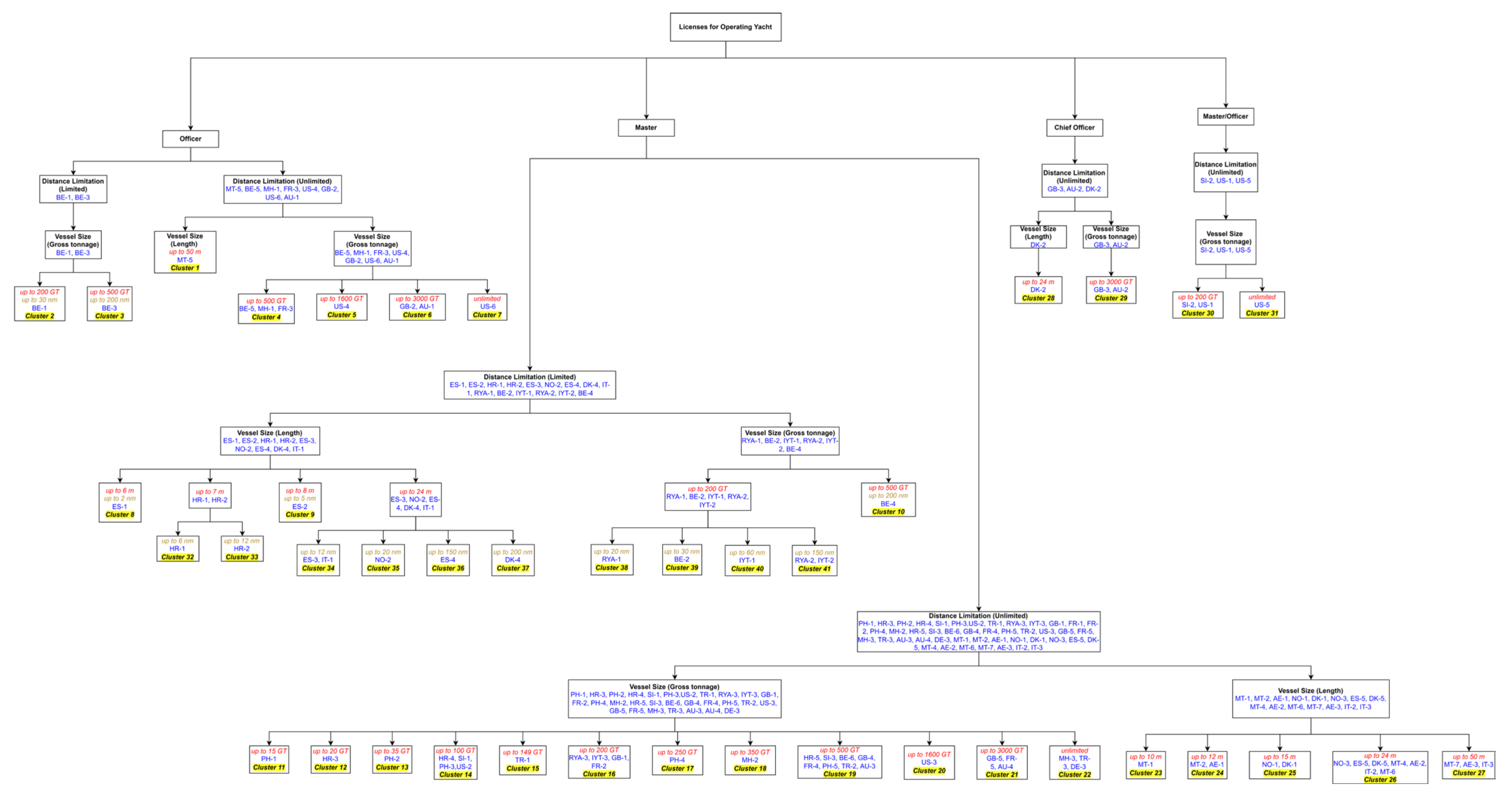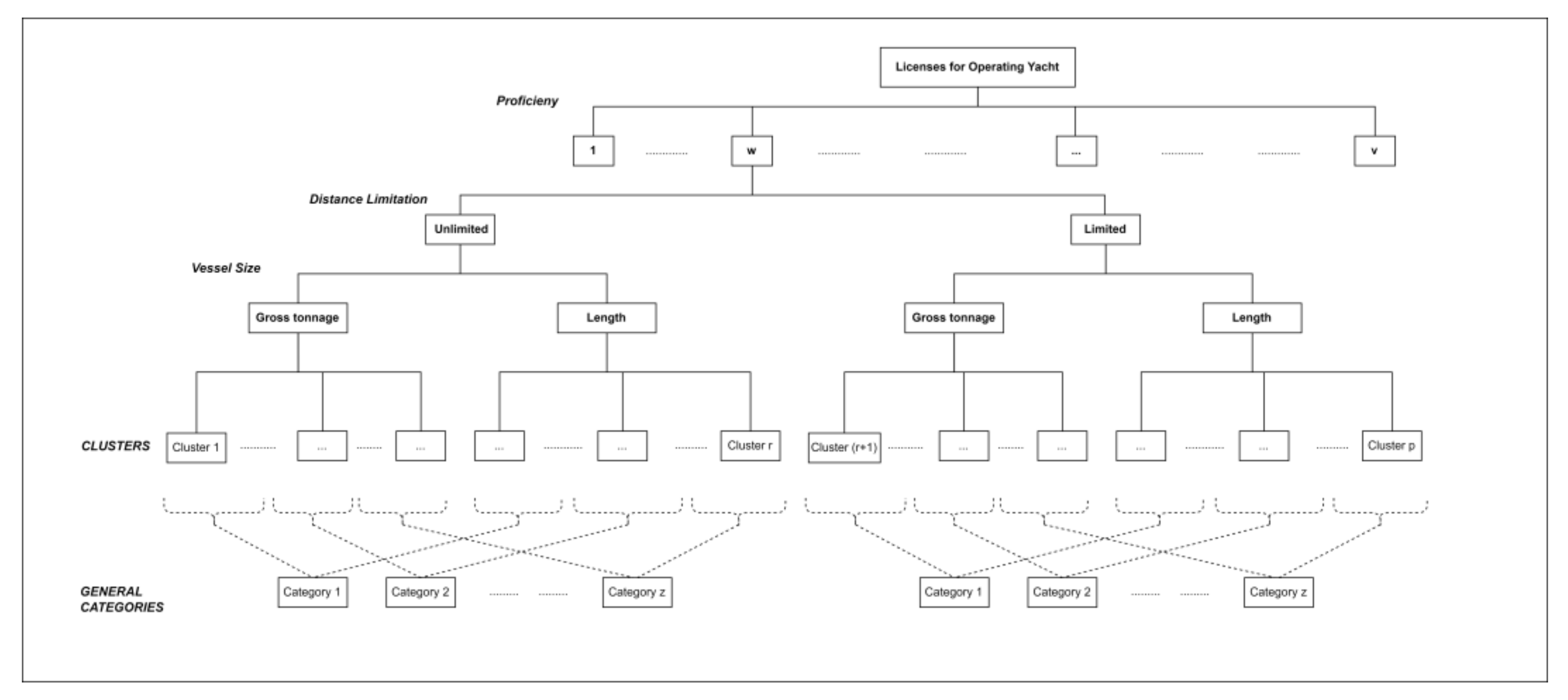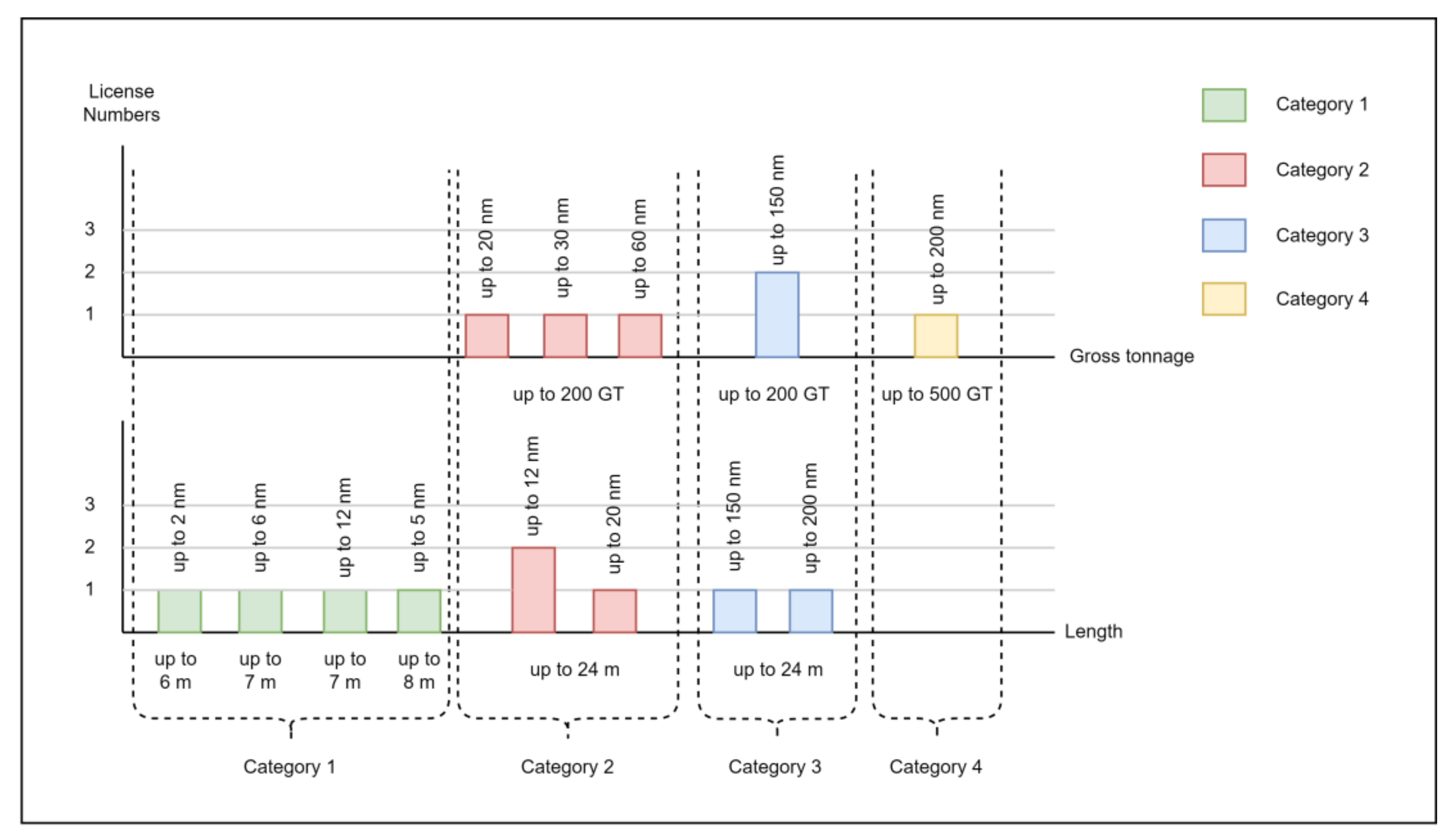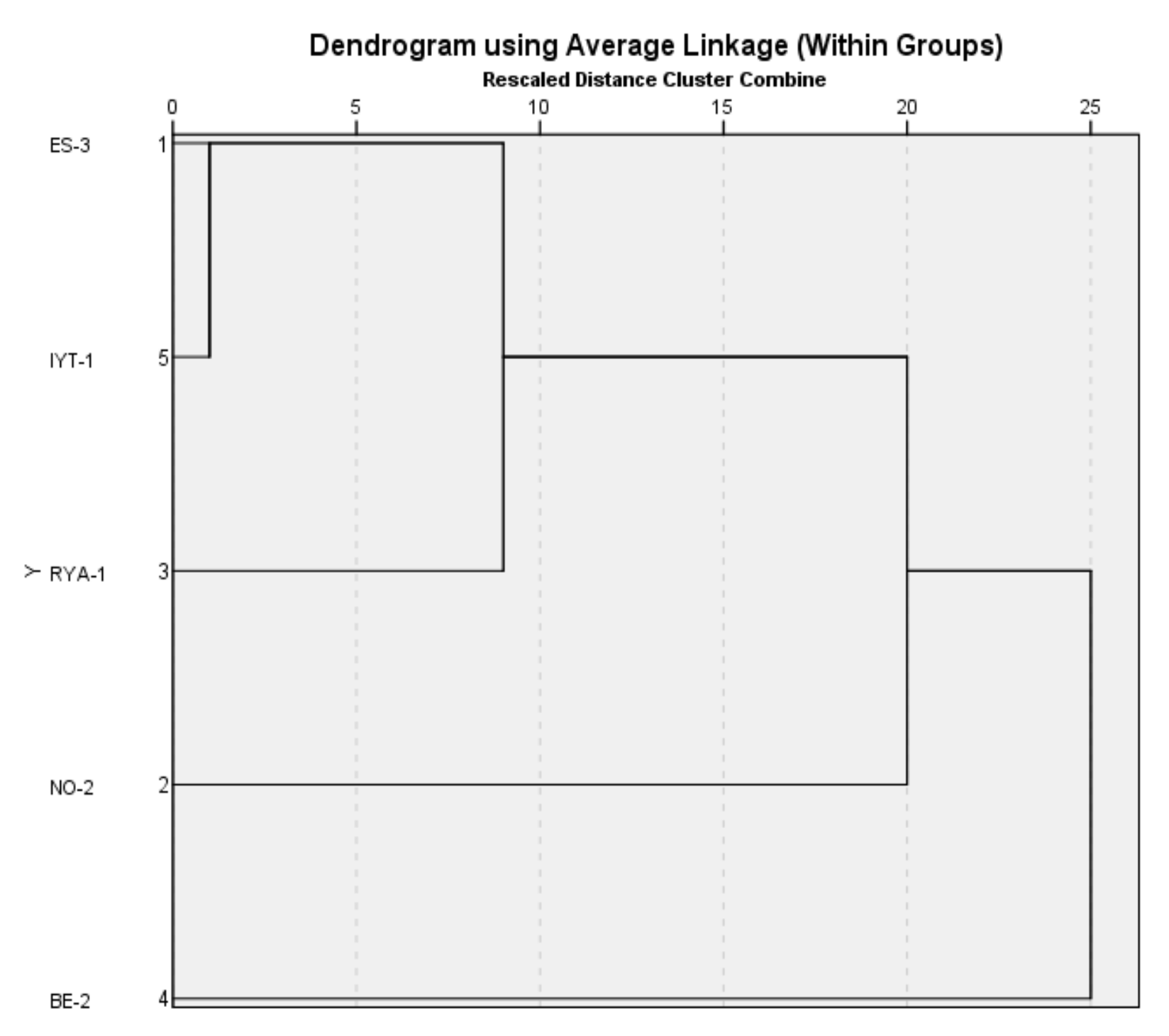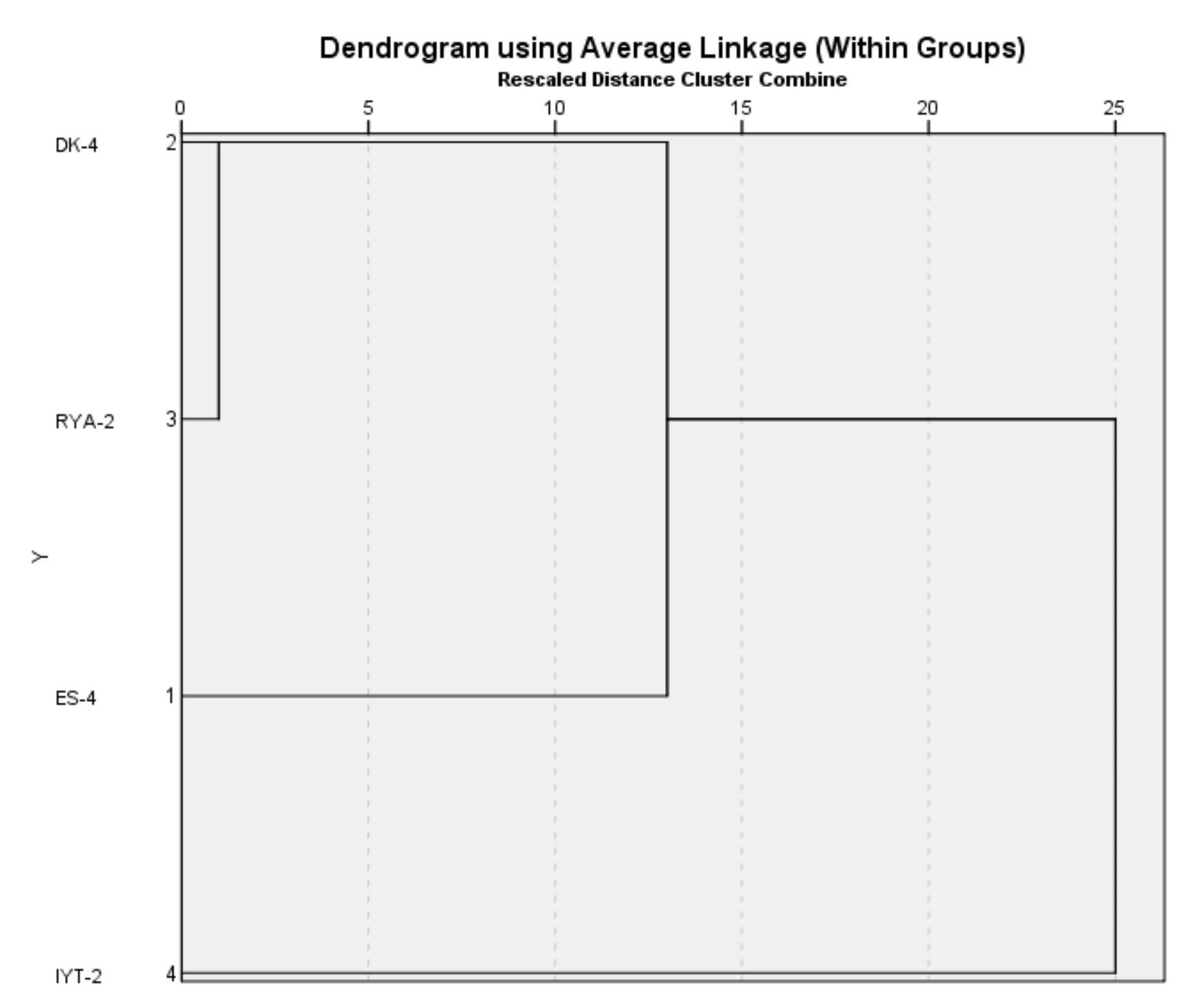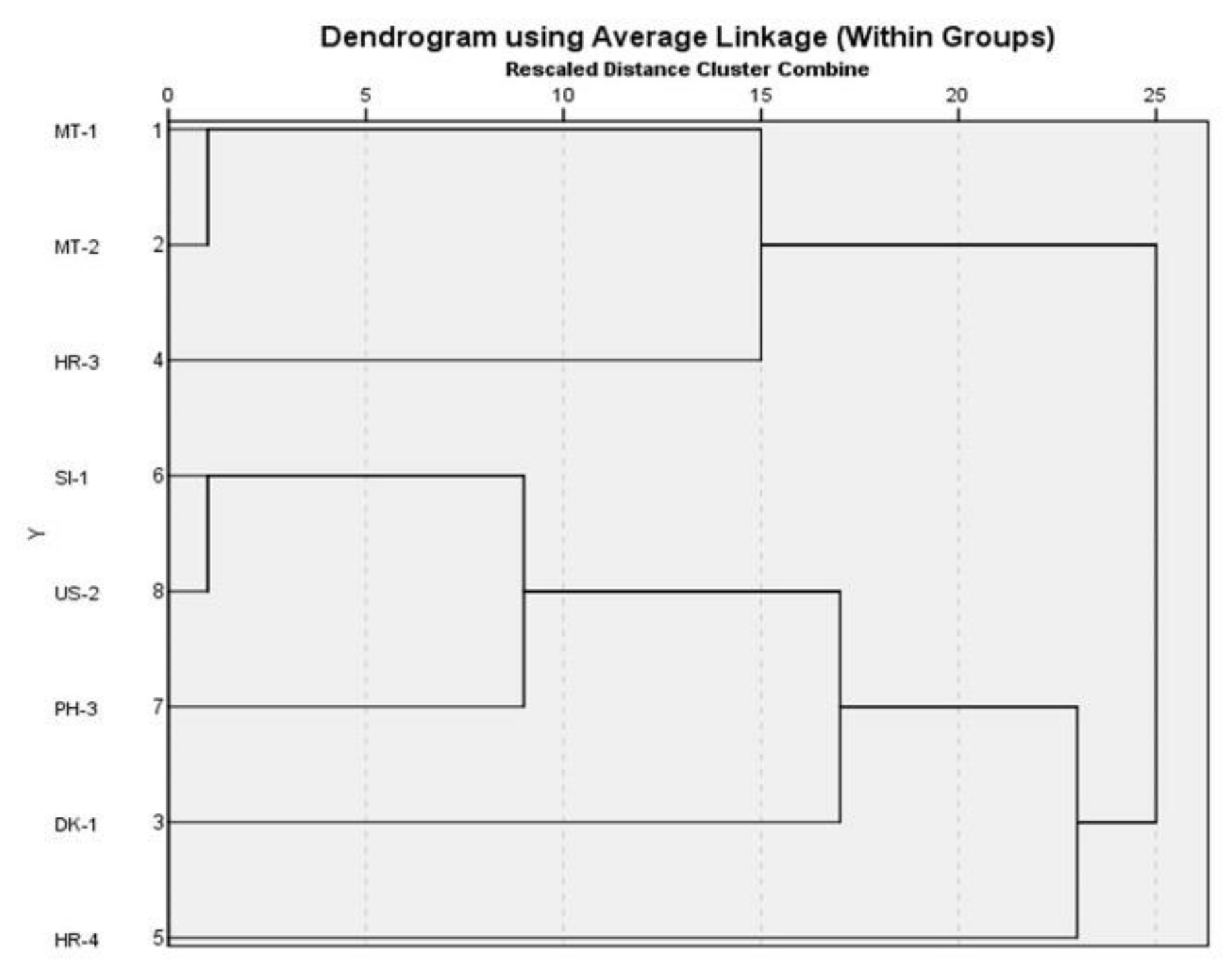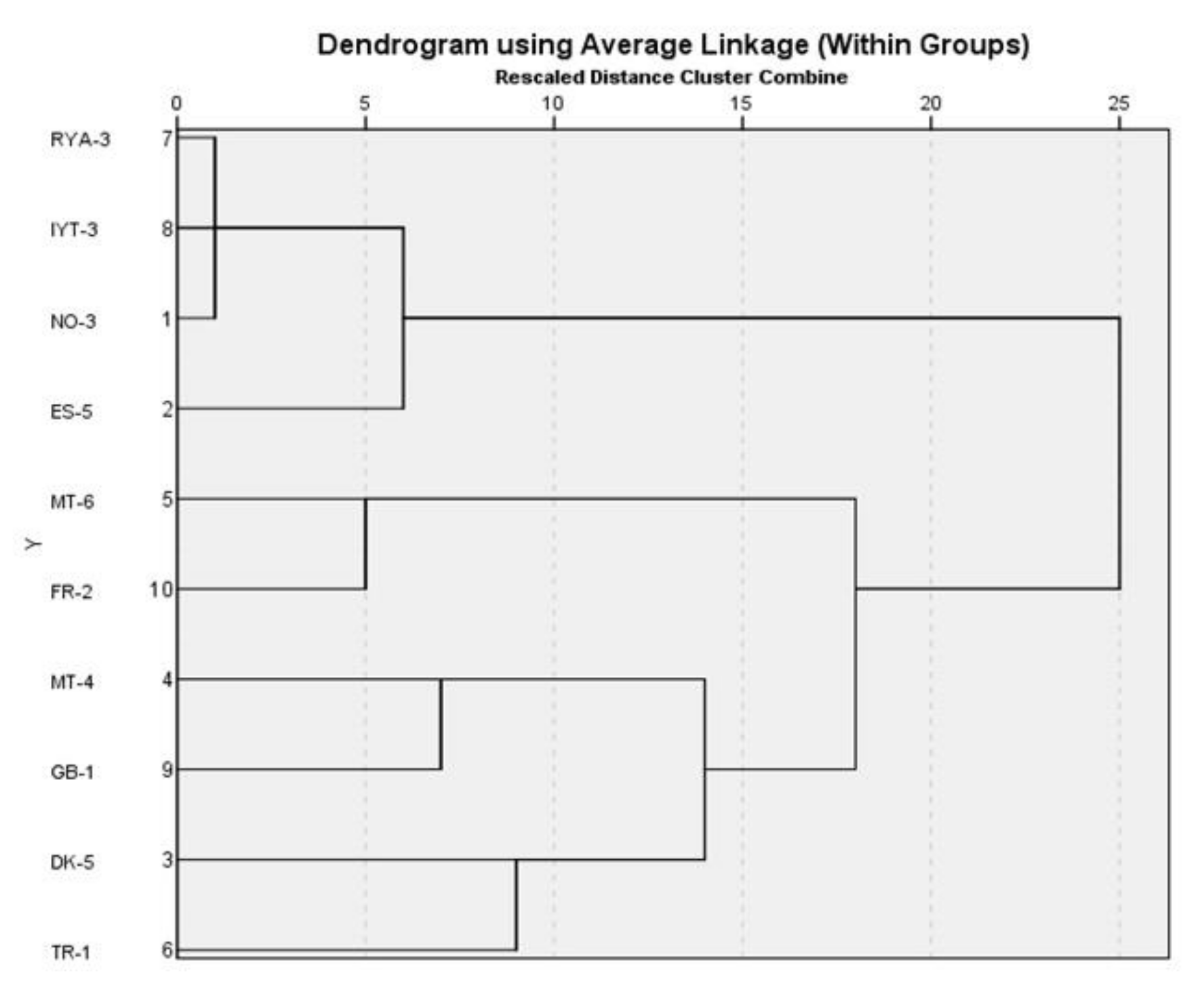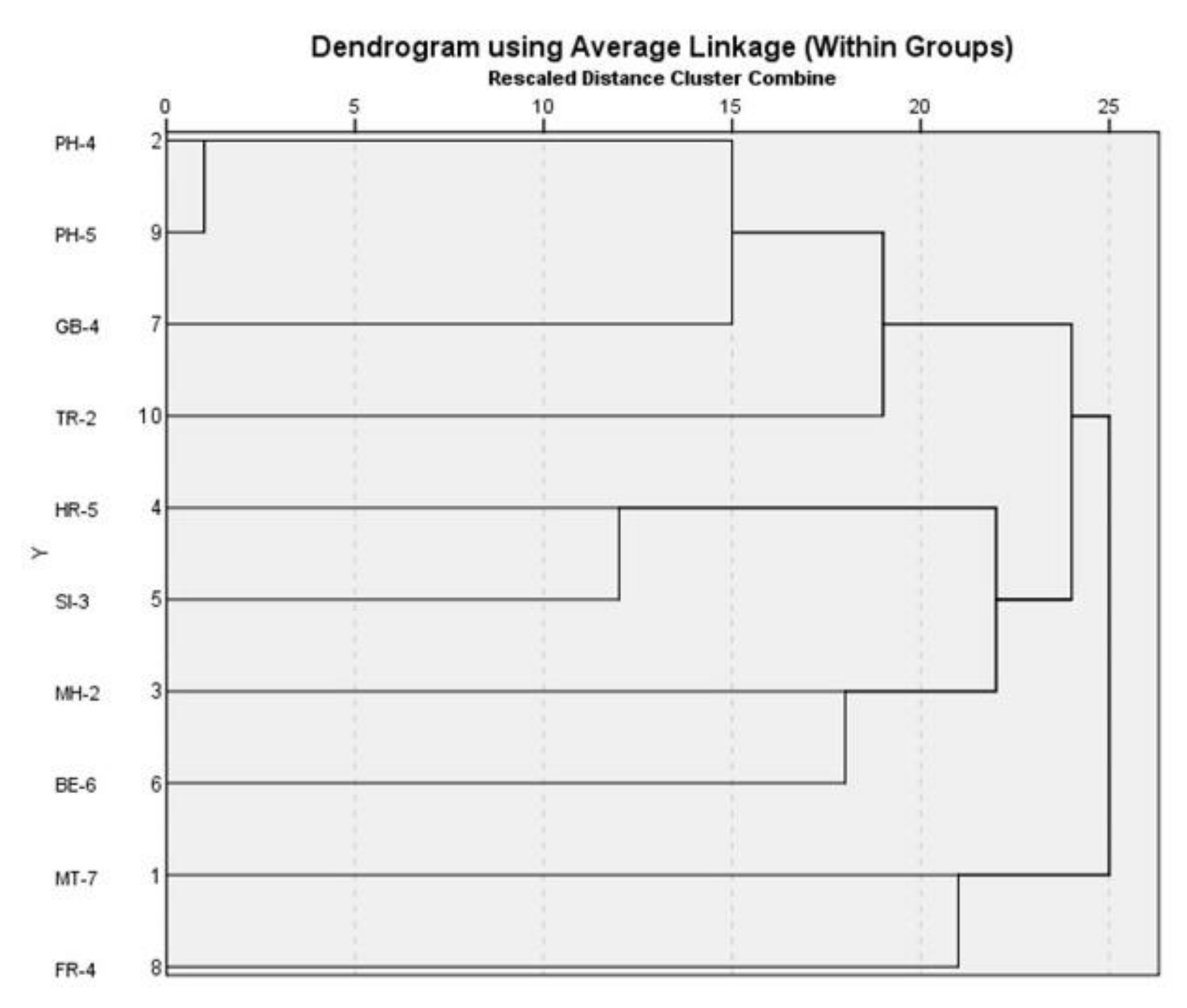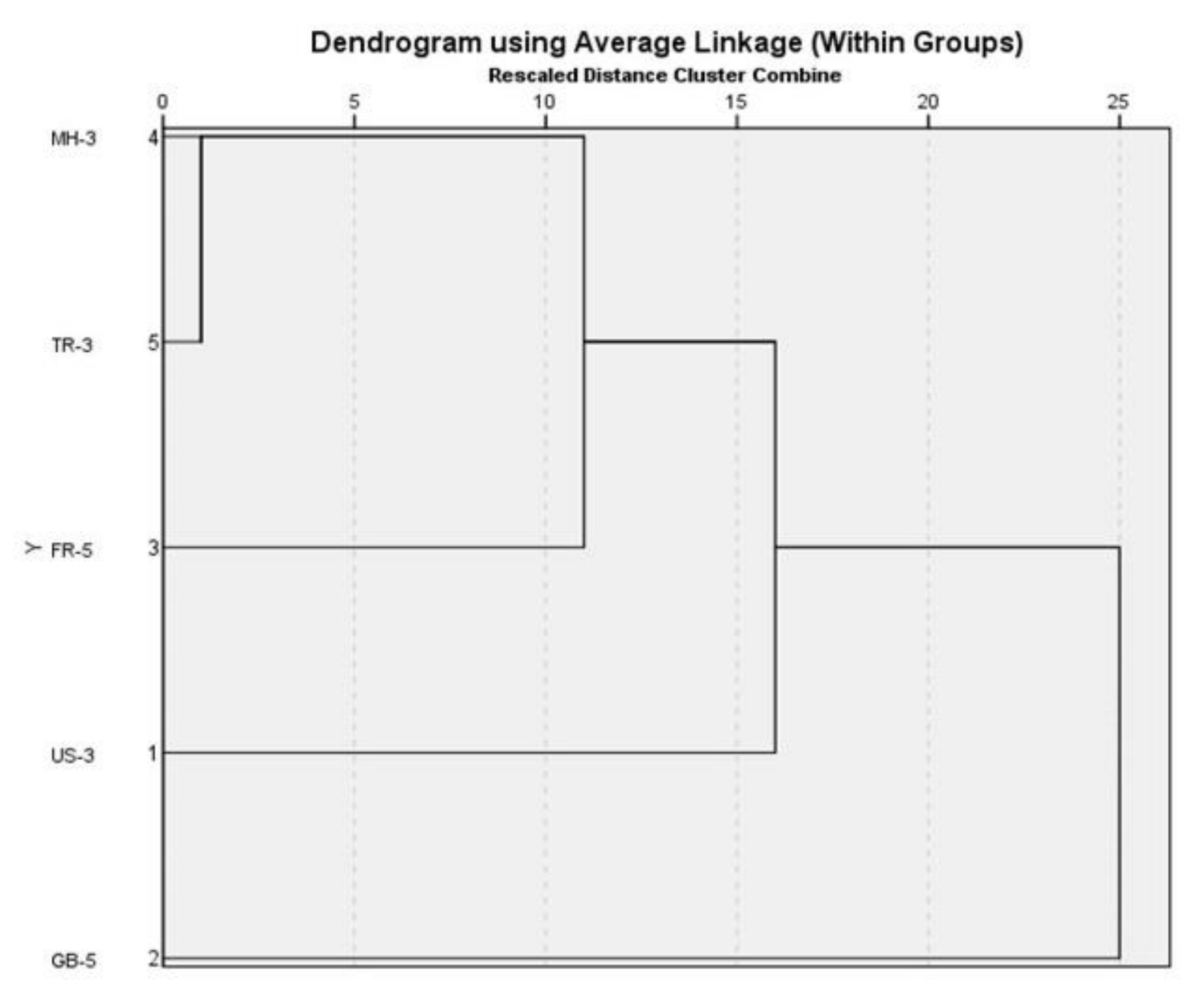1. Introduction
Yacht tourism is an important component of the marine tourism sector. It has some advantages such as vacationing with nature and in a less crowded environment, as well as discovering natural beauties without being dependent on a place. Therefore, it has become a popular option for those who want to get away from the hustle and bustle of city life. Especially in the last decades, depending on the economic developments, the demand for yachting and boats has increased. In 2020, the size of the global yacht market reached USD 12 billion [
1]. Even during the COVID-19 pandemic, this interest has grown more due to the desire for a more isolated holiday [
2,
3]. The yacht industry has worked hard during this time, and its employees have worked more overtime than in previous years [
4]. It is expected that this increasing trend in demand will continue in the coming years [
1,
5]. According to market analysis, by 2027, the growth rate for yachts between 24 and 45 m is estimated to be around 5%, and revenue is predicted to expand at a compound annual growth rate of over 4.5% [
1].
Many stakeholders are involved in the yachting sector, including yacht manufacturers, marine engines, yacht equipment, technical maintenance, marinas, and agencies. In this respect, yacht masters are essential in this sector and play an important role in its sustainability. That is, there is fierce competition among companies, particularly in terms of design and comfort, and many innovative products have been included in the sector [
5]. In this direction, customers began to prefer comfortable and fully equipped cabins, and their service quality expectations have grown. Parallel to these developments in the sector, the demand for qualified yacht masters has also increased. The main responsibility of yacht masters is safe navigation and management of the crew. However, depending on the boat’s characteristics, they are also responsible for doing many things correctly, such as preparing the meals, choosing the products to be offered, and cleaning the cabins. At the same time, they are expected to have in-depth knowledge about the bays and to make precise planning like an organizer so that the passengers can have a pleasant time [
6]. The level of satisfaction of the passengers on the yacht depends on the master’s approach to them and the fun time they spend on the yacht, as well as the condition of the boat. The qualifications of them play an important role in meeting the demands of the customers. In this regard, their education is of great importance to train qualified professionals who have the knowledge, culture, and professional ethics [
6]. In addition, today, yachts can cruise not only in their territorial waters but also all over the world. Therefore, like all seafarers, their qualities are also important in terms of maritime safety. Studies indicate that yachts are involved in a significant number of maritime accidents [
7,
8]. For example, yacht accidents rank second after general cargo accidents in Turkish search and rescue area [
7]. To reduce the number of accidents, manufacturers are increasingly adopting safety measures and installing safety equipment onboard [
1]. However, operator inexperience and carelessness are among the leading causes of yacht accidents [
8].
As it is known, to decrease the risks arising from maritime transport, various international conventions that set up standards regarding the protection of the marine environment, the safety of the ship, cargo handling, and crew competency have been introduced by the International Maritime Organization (IMO) and the International Labor Organization (ILO) [
9]. In this respect, the Training, Certification, and Watchkeeping Standards of Seafarers (STCW 78/95) sets up requirements for countries to establish their maritime education. However, training for the Small Commercial Vessel (SCV) is not covered by this convention, and each country is allowed to implement its system. Therefore, each country has different formations of training programs and licenses. In some countries, it is necessary to take training to qualify for operating boats and yachts, whereas, in others, it is sufficient to be successful just by taking the exam. Some countries have additional requirements for obtaining a qualification, such as the length of time spent in the sea and the required certificates. Furthermore, their training programs are vastly different. More importantly, there is no standard for limitations of licenses for yacht masters and officers. While some countries classify them based on the tonnage of the yachts, some categorize them based on their length. Furthermore, each country has a different number of license/certificate classes. The master’s competencies differ among these licenses as well. Besides these country-specific yacht master’s licenses, there are international organizations such as International Yacht Training Worldwide (IYT) and Royal Yachting Association (RYA). They have agencies in more than 50 countries and provide education in various categories, and their certificates are recognized by many countries. For example, IYT licenses for commercial use are directly accepted by the British Maritime and Coast Guard Agency (MCA), Marshall Islands, Malta, Bermuda, United Arab Emirates, Poland, Latvia, and the United States Coast Guard (USCG) [
10].
Due to these disparities between countries, licenses are, of course, not mutually recognized between countries. Therefore, unlike other seafarers, workers in the SCV sector cannot work on a vessel flying the flag of other countries, even if they are qualified [
11]. Thus, it causes the problem of workforce loss. This situation is an important issue, especially for the regions where yachting is popular, such as the Mediterranean and the Caribbean. In addition to this problem, the lack of a standard for training is another important problem. The standardization of qualifications, especially professional licenses, as in commercial ships, is essential to ensure maritime safety worldwide. In this way, the identification of the similarities of yacht master training and licenses globally is an important task for harmonization and standardized studies. However, even determining which qualification in one country is equivalent to which in another presents significant challenges due to vast differences between them and the lack of data.
In this respect, there are some regional initiatives for the mutual recognition of qualifications. That is, the Transnational Recognition of European Certification in Vocational Education and Training Project (TRECVET), which aims for the adaption of qualifications in the European Union (EU)’s SCV sector among the Member States’ authorities, was generated [
12]. A comparison tool for the syllabi of a similar skipper qualification of three countries (The United Kingdom—Yachtmaster Offshore Commercial, Spain—Patrón Profesional de Embarcación de Recreo—PPER, and Germany—SportSeeSchifferschein-SSS) was developed as the project output. Later, TRECVET Core Curriculum for Skippers of Small Commercial Vessels (TCC-SCV) analyzed professional SCV skipper qualifications (up to 24 m or 200 GT) from seven EU Member States (the United Kingdom, France, Spain, Germany, Slovenia, Czech Republic, and Croatia); compared their commonalities and differences; and proposed a solution tool [
13].
In addition to these initiatives, several academic studies on qualifications for yachts have been carried out so far. However, these studies do not address the issue globally and do not aim to determine which qualification in one country is equivalent to which in another as a category. Some of these studies compare the qualifications of a particular country with the qualifications of other countries for the mobility of seafarers, while some reveal the importance of the subject to the EU. Mišković et al. compared skipper training programs of the United Kingdom and Croatia under the EU Project of TCC-SCV [
14]. They stated that there are differences between these programs, such as training schemes, practical courses, and required sea experience, in particular. Ziarati et al. revealed the importance of the issue for the EU countries concerning the TRECVET [
11]. They discussed the aims and impacts of TRECVET. Unlike these studies within the scope of the TRECVET project, Iussich and Mohović discussed the challenges that domestic and international skippers and yacht masters face when working in Croatia and compared them in terms of maritime safety, service quality, and regulations [
15]. In another study, Ozbey compared the education and qualifications in Turkey with some countries [
6]. He offered suggestions for the employment of yacht captains.
This study aims to analyze the similarities of the qualifications for operating yachts. In this respect, a two-stage methodology is used. First, the licenses are categorized according to proficiency, distance limitations, and vessel sizes. Then, using a clustering analysis, the similarity of their courses is detected for the overall evaluation. As a result, the levels of similarity between internationally recognized licenses and other licenses are discussed. In addition, a classification method similar to that for watchkeeping officers’ licenses is proposed for standardization of the yacht license categories based on distance limitations, tonnage, or length.
4. Discussion
The yacht license categories of countries are quite different from each other. Some of these categories belong to the proficiencies of officer, chief officer, and master/officer, in addition to master. Furthermore, the classification of the licenses differs among countries. The fact that there are 41 different clusters reveals this difference in classification. Each of which represents a category in terms of proficiency, distance limitations, and vessel sizes.
When license categories in the limited master are investigated, it is seen that they have four license categories in terms of length and two categories in terms of gross tonnage. On the other hand, there are nine different categories in terms of distance limitations. In this respect, it is said that the most common classifications in the limited category are up to 200 GT in terms of gross tonnage and up to 24 m in terms of lengths. However, there is no commonly used category as a distance limitation under these categories. Even IYT-1 and RYA-1, which are in the same category according to gross tonnage, do not have the same distance limitations. That is, while the IYT-1 limitation is 60 nm, that of RYA-1 is 20 nm. It can be said that the distance limitations used in general for the whole limited category are up to 12 nm, 20 nm, and 150 nm.
As for unlimited master license categories, it is seen that there are 5 license categories according to their length, while there are 12 different categories according to gross tonnage. Categories with at least four licenses in terms of gross tonnage are up to 100 GT, up to 200 GT, and up to 500 GT. On the other hand, in the classification by length, only the category up to 24 m contains more than four licenses. This indicates that these gross tonnage and length of categories are most commonly used in this proficiency.
Another noteworthy situation about categories in classification is that 26 out of 41 clusters contain only one license. This means that there are no other licenses that are in the same category. This is also an indicator of the large variations in the differences in the categories used by countries. This finding complies with the results already reported in the literature [
6]. However, it should be noted that the reported results belong to the similarity of countries based on license categories, not the similarity of licenses. That is, the number of exact similar licenses as a category is only two in each chief officer and master/officer qualification. On the other hand, it is observed that the number of exact similar licenses as a category in master qualification is much higher than these proficiencies. This indicates that the proficiencies of officer, chief officer, and master/officer are less commonly used compared to the master. However, there is also a great difference between the limited and unlimited categories of master proficiency in terms of exact similar licenses. In limited master proficiency, only, there are two exact similar licenses in terms of both length and distance and two exact similar licenses in terms of gross tonnage and distance limitation. It is noted that the exact similar licenses in terms of gross tonnage and distance limitation are RYA-2 and IYT-2. On the other hand, in unlimited master proficiency, four out of nine exact similar license clusters have at least four licenses. This demonstrates that unlimited master proficiency categories are more widely used than all other proficiencies.
In this direction, the similarity analysis for the courses has been made only for the master’s license categories, as they have more widespread use. The similarity analysis in terms of courses for the limited master category shows that the licenses have a very wide range of similarities. There is more similarity between the licenses in category 2 compared to category 3. Furthermore, among all licenses taken into consideration, two exact similar licenses in terms of the courses ES-3 and IYT-1 are included in category 2.
On the other hand, when course similarities of licenses in the unlimited master categories are investigated, it is seen that there is low to very low similarity between most licenses in these categories. Only in unlimited categories 1 and 3, several licenses are similar to each other at a very high level. In addition to these, two licenses with a high level of similarity are also in category 1. However, some of these licenses with very high or high similarities are the licenses of the same countries in different categories. Among them, only US-2 with SI-1, and PH-3 with SI-1 in category 1 are highlighted as different country licenses. That is, US-2 and SI-1 are the licenses with the highest similarity, and PH-3 with SI-1 are the licenses with the second-highest similarity in the unlimited category. Another remarkable point is that a significant part of the licenses in unlimited category 2 has a similarity value of 0. It shows that there is no similarity between the courses of these licenses—that is, they are dissimilar. The feature of this category is that IYT-3 and RYA-3 are here. IYT-3 is not similar to any of the other licenses in this group, except for NO-3, ES-5, and RYA-3, while there is a similarity level that varies between the very low and moderate levels between RYA-3 and others.
When the course similarity of the exact similar licenses in terms of categories is examined, it is seen that the group with the most similar values ranging from moderate to very high are HR-4, SI-1, PH-3, and US-2 (up to 100 GT) in unlimited category 1, except for HR-4. Exact similar licenses in other categories generally have a low to very low level of course similarity. Even in limited category 3, the course similarity of RYA-2 and IYT-2 is at a low level. This is a surprising result, as these licenses are internationally recognized licenses. On the other hand, RYA-3 and IYT-3 in unlimited category 2 have a moderate course similarity level. However, there is a very low similarity between them and GB-1 and FR-2 that are exactly similar to them. Even GB-1 and FR-2 have 0 similarities with IYT-3—that is, they do not have any common courses. Similarly, NO-3, ES-5, DK-5, MT-4, and MT-6 with other exact similar licenses in unlimited category 2 have a low or very low similarity. Notably, ES-5 is dissimilar to them with a 0 value, except for NO-3. This situation regarding exact similar licenses in terms of classification in category 2 also exists in those in categories 3 and 4. That is, most of them have low to very low similarity levels in terms of courses. There is even no similarity between FR-4 and GB-4, which are the only dissimilarity licenses in category 3.
In the meanwhile, although there are no exact similar licenses among the limited category 2 licenses, licenses having the highest level of course similarity are found here. That is, RYA-1 and IYT-1 with up to 200 GT are not in the same category according to the distance limitations, but they have a high similarity of courses. Furthermore, ES-3, which is in the same category as neither IYT-1 nor RYA-1, is highly similar to RYA-1 and exactly similar to IYT-1. This similarity relationship between them is depicted by a gradual structure in the dendrogram for limited category 2. According to the dendrogram, ES-3 and IYT-1 are linked first with the most similar courses, as well as RYA-1. This means that IYT-1 and RYA-1 are similar to a certain extent. The same dendrogram structure is observed within limited category 3. The most recent connection of IYT-2 to the group of RYA-2, DK-4, and ES-4 is the most similarity shown that it is least similar to this group.
Unlike the dendrograms for limited categories, dendrograms for unlimited categories 1, 2, and 3 have two main clusters. This means that the licenses in these categories are grouped into two main groups in terms of course similarity. It is noted that there is a very low course similarity between these main clusters. In addition, the characteristics of these main clusters differ from each other. Some of them have a gradual structure, while others are composed of subclusters. In category 1, both main clusters have a gradual structure. On the other hand, while in category 2, only one of the main clusters has a gradual connection to each other, such a structure in category 3 is not observed. This gradual structure shows that, except for the first connected licenses, each of the other licenses has a low similarity value with each other, and they are most similar to these two licenses that are connected first. Furthermore, in each category, one of the main clusters contains many more elements than the other. Even in category 3, there are two elements in one of the main clusters. This indicates that only these two elements are very different from the other elements in this category.
In addition, a striking situation regarding each main cluster is that the first element or cluster connected to the cluster formed in the first stage is linked to this cluster at least at a rescaled distance of 10, generally. This is an indication of the low level of similarity between licenses. Only the licenses in the first main cluster in unlimited category 2 differ from the others in this respect. In this cluster, ES-5 is connected to IYT-3, RYA-3, and NO-3, which are equally similar to each other in a close order of about six. In this context, it can be stated that this group has the most similarity among all the licenses.
Only 17 countries were included in the analysis due to a lack of data. However, most of these countries are the leading countries in the sector, and the inclusion of RYA and IYT ensures that the results are representative. In addition, unlike other studies in the literature, course similarities have been determined as quantitative. This is valuable in terms of objectively revealing the general situation. More important, this is the first study in the literature on the classification of licenses and the identification of general categories.
In the study, three tiers have been used to classify the licenses. The proficiency has been chosen as the first tier, and the distance limitation as the second tier. The feature about vessel sizes is covered in the last tier. Of course, vessel sizes could be chosen instead of the distance limitation in the second tier. This classification has been chosen so that it is compatible with merchant vessels. Licenses are divided into two groups as limited and unlimited, depending on their proficiency, similar to watchkeeping officer licenses. As it is known, watchkeeping officer licenses are divided into two as oceangoing and near-coastal. This classification is envisaged to serve as a foundation for the standardization of yacht master’s licenses. In this respect, in addition to the exact similar licenses determined by the classification in the first stage, it has also been determined which of the licenses classified according to the ship tonnage or length can be equivalent to each other. These general categories, which are determined under limited and unlimited competencies, will eliminate the confusing situation in determining licenses that are similar to each other as a category. This is especially important in terms of the harmonization of license categories.
The courses used as criteria in the study have been determined based on the courses of all the licenses considered. Some topics that do not have the same name have been evaluated in appropriate courses. Undoubtedly, other factors should be taken into account to determine the similarity of the training. For example, other important issues regarding the training are the course durations; the pre-course experience required for practical courses such as duration, minimum age, and days at sea; and pre-exam requirements such as sea time and certifications. However, there is a great variation between licenses in these matters as well. Moreover, it is difficult to obtain data on these issues for all evaluated countries. In the meanwhile, if these data on all the considered countries are obtained, their similarities can be examined with the same method for a general evaluation.
In this respect, to harmonize the two licenses with each other in practice, it is necessary to compare them specifically, taking into account all these issues. On the other hand, although this study only evaluates the similarity of the courses, it still provides a general evaluation in terms of similarity. In fact, the generally low-level course of similarity detected in the study can be considered as an indicator of a low level of similarity in other subjects. This finding complies with the results of a previous study in the literature [
14], even though only skipper training programs of two countries were compared in this study. Considering all these variations in categories and their similarities, the study revealed the necessity of establishing a standard regarding the classification of licenses and internationally determining the minimum requirements for their education, as in STCW.
5. Conclusions
Forty-one different categories consisting of the proficiencies of the master, officer, chief officer, and master/officer in terms of distance limitations and vessel size are detected in the clustering of licenses for operating yachts. The most commonly used categories in limited master licenses are up to 200 GT in terms of gross tonnage and up to 24 m in terms of lengths. There is no such common use in terms of distance limitations, but up to 12 nm, 20 nm, and 150 nm are more prominent than others. On the other hand, unlimited master licenses categories with at least four licenses are up to 100 GT, up to 200 GT, and up to 500 GT in terms of gross tonnage and up to 24 m in terms of lengths. All other categories are mostly country-specific.
The courses similarity matrices for master categories detected that most countries’ licenses have low to very low similarity levels with each other and with the categories of RYA and IYT. It has been seen that some licenses that are exactly similar to each other as a category do not have any common course. According to the dendrograms, IYT-3, RYA-3, NO-3, and ES-5 clusters in unlimited category 2; ES-3, IYT-1, and RYA-1 clusters in the limited category; and SI-1, US-2, and PH-3 clusters in unlimited category 1 are the most similar licenses clusters. All other licenses that are in the same main/subclusters with these clusters have very low similarities with them.
These great diversities in the licenses of countries for operating yachts, both in terms of categories and courses, revealed by the similarity analysis demonstrate the necessity of a standard for them. In this respect, standardizing license categories will help eliminate the confusion about which license is equivalent to which and harmonize licenses with each other. For this purpose, four general categories under limited and unlimited competencies for similar licenses that can be evaluated in the same category have been determined in this study. It is envisaged that this classification would form a basis for the standardization of the yacht master license categories. Furthermore, internationally, the determination of the minimum training requirements for each category, as in STCW, will improve the quality of education, thus also ensuring maritime safety worldwide. In this regard, it is necessary to conduct studies on this issue by the IMO, in addition to regional initiatives. Based on the education programs of the leading countries, a training program for each category that can be implemented by all countries should be created. In addition, an effective control mechanism should be established. Additionally, it is necessary to carry out academic studies to help the standardization effort. This study can practically serve the authorities as a starting point for the standardization of yacht license categories and training. Future research should focus on identifying the optimum standards for yacht training and how to sustain them.
